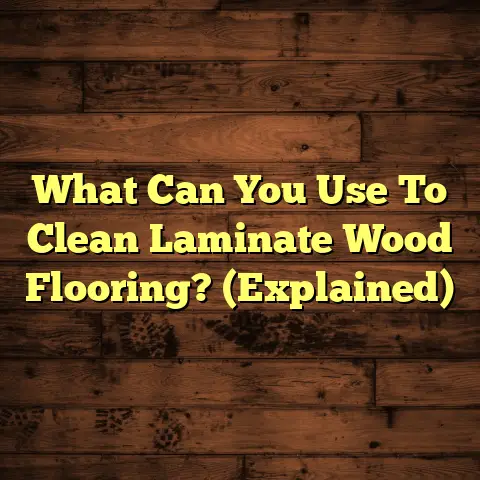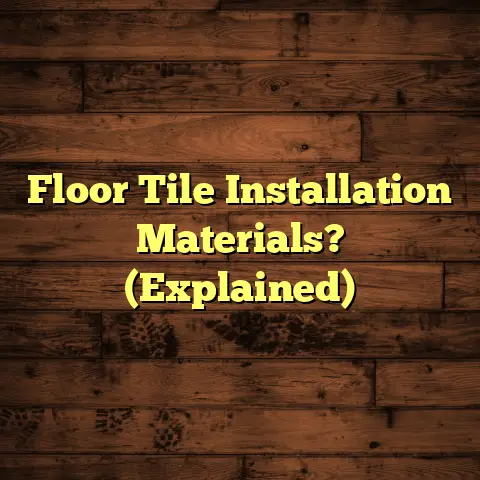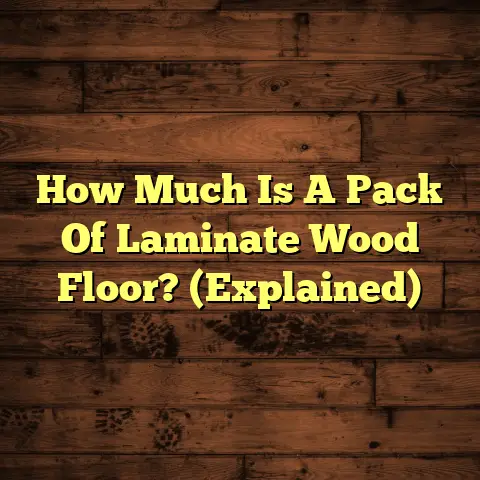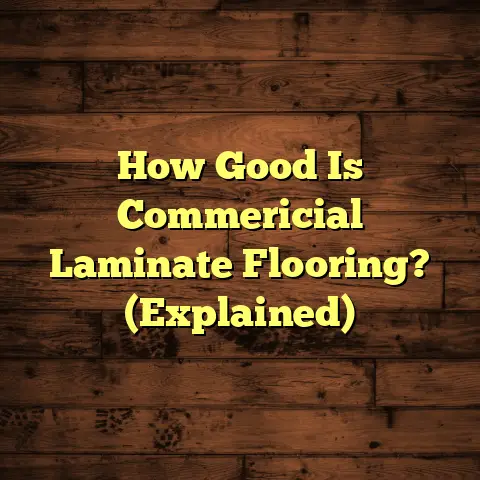Do I Need A Vapor Barrier Between Concrete And Wood Flooring? (Explained)
There’s a curious paradox in the flooring world:
the very materials we use to create beautiful spaces can also be the source of significant problems.
Take, for example, the question of vapor barriers between concrete and wood flooring.
On one hand, a vapor barrier protects against moisture infiltration,
but on the other hand, an improperly installed barrier can trap moisture, leading to mold and deterioration.
As a seasoned flooring contractor, I’ve wrestled with this issue many times,
and my experiences have taught me invaluable lessons about moisture management in flooring installations.
The Importance of Understanding Moisture
Moisture is often an unseen enemy.
It can infiltrate your home quietly, affecting the integrity of your wood flooring without any immediate signs.
In my early days as a contractor, I worked on a project in the outskirts of Dhaka.
The homeowners were thrilled to install beautiful engineered hardwood over their new concrete slab.
However, I had a nagging concern about moisture levels in the area.
In this case, the concrete slab was newly poured, and while it looked perfect on the surface,
I knew that moisture could still be lurking beneath.
This experience taught me the critical importance of assessing moisture presence before proceeding with any flooring project.
Evaluating Your Environment
When considering whether to use a vapor barrier, you must assess your specific environment.
I always start with a few key questions:
- What is the climate like?
In humid areas, like coastal regions or places with heavy rainfall, moisture control becomes essential.
During one summer in Chittagong, I installed flooring in a home where humidity levels reached over 80%.
In scenarios like this, I always recommend a vapor barrier. - Do you have a basement or crawl space?
If your home has either of these, they can be a significant contributor to moisture issues.
In one project, I found that a client’s crawl space was damp due to poor drainage, which ultimately affected the wood flooring above. - Is the concrete slab new or old?
New concrete can take months to cure and dry out completely.
I learned this lesson the hard way when I rushed a project without allowing adequate drying time—leading to warping and buckling.
Types of Vapor Barriers
If you determine that you need a vapor barrier, you’ll find several options available to you.
Over the years, I’ve experimented with various types. Here are some insights based on my experiences:
- Plastic Sheeting: This is perhaps the most common choice for vapor barriers.
Made from polyethylene, it’s effective and relatively inexpensive.
In one project, I used 6-mil plastic sheeting for a large installation in Dhaka.
It worked well as a barrier against moisture being easy install2. **Foam Board Insulation: While primarily used for insulation purposes, boards can also serve as an moisture barrier. another project where insulation was needed, I installed foam boards and they provided excellent moisture control as well. - **Liquidbrane: This option is applied as a that cures to form a seamless barrier.
I once this for an irregular surface installation; while was more expensive than plastic she, it proved beneficial in preventing moisture issues.
Installation TechniquesProper installation of vapor barrier is for its effectiveness.
are some techniques that I’ve found helpful over the years:
- Surface Preparation: Before down any vapor barrier material, that the concrete slab is clean and dry.
I once encountered debris left on the surface previous, which compromised the barrier’s. - Overlap and Seal: When using plastic sheeting overlap seams by at least 12 inches tape them securely.
This attention to detail prevents moisture seeping through gaps.
Edge Sealing: Don’t forget to seal the edges your vapor barrier to the walls and any penetrations.
creates a continuous barrier and minimizes potential leaks.
Cost ConsiderationsCost is always a factor when planning any project.
In my experience, FloorTally has been an invaluable tool for estimating costs accurately
For example, when estimating expenses for recent project involving both vapor barriers and wood flooring, FloorT helped me break down costs- Plastic Sheeting: $0.20 per square foot.
- Labor for Installation: Estimated at $1.00 per square foot.
- **Total Estimated Cost: Roughly $1.20 per foot for materials and labor combined.
Having these figures allows me to present clients with clear budgets—
which critical for maintaining trust and transparency### Challenges Encountered
Even with careful planning and execution, challenges arise during.
One memorable project involved installing hardwood flooring over a concrete in Chittagong.
Despite following all recommended practicesusing a quality vapor barrier and ensuring proper sealing—we still encountered unexpected groundwater issues beneath the property.
some investigation I discovered that heavy rains had caused water to pool near foundation, leading to excess moisture under the floor.
This taught me that sometimes factors beyond our control impact even the-prepared installations.
Comparing Different Approaches
Throughout my career, I’ve explored methods regarding vapor barriers.
I’ve learned that there’s no universal solution; each project presents unique challenges and opportunities- Plastic Sheeting Alone: In some, relying solely on plastic sheeting has resulted in unsatisfactory outcomes due to moisture issues resurf after installation. -Combination Approaches**: I’ve found success when plastic sheeting with foam board. This approach has yielded better durability and moisture control.
Maintenance andgevity
After installation, regular maintenance is key to extending life of your flooring.Keeping an eye on humidity levels within your home can prevent future issues.
I often recommend using hygrometers monitor moisture levels effectively.
For, I had clients who neglected to monitor their humidity levels after hardwood flooring a vapor barrier.
Within months, they experienced buckling andping—an issue that could have been avoided with proper humidity control.
Impact of Local Conditions
Every region has unique environmental conditions that affect flooring installations.
In my experience working in, I’ve encountered high humidity levels that impact flooring significantly.
For example:
- In coastal areas like Cox’s Bazar, where levels be extreme, I always prioritize management strategies.
- Conversely, in northern regions like Sylhet, where winters are cold dry moisture issues may not be as pronounced.
These factors shape my recommendations to clients and guide my material choices installations### Understanding Flooring Materials
As I work with flooring materials I’ve come to appreciate how interacts with moisture differently- Hardwood Flooring: Naturally absorbs moisture the air; therefore, it’s to have an effective vapor barrier underneath.
- Engine Wood: Generally more stable than hardwood but still susceptible to moisture damage without proper precautions.
- Laminate Flooring: Often to resist moisture better than hardwood but still benefits from having a barrier beneath it.
Real-Life Examples
One of my favorite involved restoring an old home inaka where we uncovered original hardwood floors beneath of carpet and linoleum.After removing these, we discovered significant damage that required careful remediation before reinstalling new flooring.
Using combination of plasticeting and foam board allowed us to protect the newly restored floors future moisture issues.
This project exemplified how conditions and using appropriate materials can to successful outcomes.
Client Education
I’ve found that clients about moisture is just as as the physical installation itself.
In cases, clients are unaware of how their actions can impact flooring after installation complete.
For instance:
- I often explain the significance of using dehumidifiers in damp areas of their homes.
- I also stress importance regular maintenance checks on humidity levels—especially during rainy seasons.
Long-Term Benefits
Taking the time to install vapor barrier properly off in the long run.
’ve seen clients enjoy their flooring for years without significant issues because we prioritized management during installation.
For example- One family in Dhaka has lived in their home for over a decade after we installed engineered hardwood a carefully constructed barrier system.
- They’ve experienced minimal wear and tear despite living through several monsoon seasons.
These-term successes reinforce commitment to educating clients vapor barriers and their critical in preserving flooring integrity.
Conclusion Making Informed Decisions
Deciding whether to install a vapor barrier between concrete and wood flooring requires careful consideration of various factors to your environment.
Every comes with its challenges and triumphs; from understanding local conditions and material choices to implementing moisture management strategies.
Ultimately being informed about your specific allows you to make sound decisions that protect and ensure beautiful flooring for years to come!
As a with years of experience navigating these waters, I encourage anyone embarking a flooring project to consider all aspects—moisture management included!





